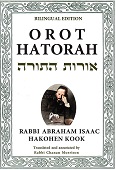
It took an old man running with myrtle twigs to stop Rabbi Shimon bar Yochai from destroying the world.
The Talmud in Shabbat 33b relates how Rabbi Shimon bar Yochai and his son secreted themselves in a cave, hiding from the Romans. They spent twelve years secluded in Torah study and prayer, living off the fruit of a carob tree and fresh water from a spring.
When at last they heard that the Roman decree had been rescinded, Rabbi Shimon and his son left the cave. But years of seclusion had transformed the two scholars. When they saw people everywhere occupied with mundane activities, plowing fields and sowing grains, they were filled with outrage. “They forsake eternal life and engage in temporal life!”
In their zeal, wherever they looked was immediately consumed by fire. Rabbi Shimon and his son were unable to reconcile themselves to the realities of everyday life, and a heavenly voice commanded them to return to their cave for an additional twelve months.
When they left the cave the second time, they came across an old man holding two twigs of myrtle branches. It was twilight, moments before the approach of the Sabbath, and the old man was running.
“What are the myrtle twigs for?” inquired Rabbi Shimon.
“They are in honor of the Sabbath,” the old man replied.
“But why two twigs?”
“One is for Zachor ['Remember the Sabbath'] and the other is for Shamor ['Keep the Sabbath holy'].”
Rabbi Shimon turned to his son, “See how precious the mitzvot are to the people of Israel!” And their minds were put to ease.
What was it about the old man and his myrtle twigs that reconciled Rabbi Shimon bar Yochai and his son to the world and its mundane activities?
Shamor and Zachor
There are a number of differences in the text of the Ten Commandments as it appears in Exodus (in the reading of Yitro) and in Deuteronomy (in Va'etchanan). One difference is in the fourth command, the mitzvah of the Sabbath. In Yitro it reads Zachor — ‘Remember the Sabbath day’ (Ex. 20:8) — while in Va'etchanan it reads Shamor — ‘Keep the Sabbath day holy’ (Deut. 5:12).
According to the Sages, these two versions are two sides of the same coin. Both Shamor and Zachor were communicated in a single Divine utterance. “God spoke once, but I heard twice” (Psalms 62:12).
Shamor and Zachor correspond to two basic aspects of the Sabbath. Shamor, keeping the Sabbath holy, refers to the quality of the Sabbath itself as a time of holiness. It corresponds to the intrinsic sanctity of the day, transcending all mundane activities, elevating us to a higher realm of holiness.
Zachor, to remember the Sabbath, on the other hand, refers to the Sabbath’s influence on the other days of the week. While we fulfill the mitzvah of Shamor by abstaining from all forms of Halachically defined work on the Sabbath, the mitzvah of Zachor is performed during the week. As the Sages explained in Mechilta Yitro, if one comes across an especially choice portion of food, one should “Remember the Sabbath” and set it aside to be enjoyed on Shabbat.
Zachor thus represents the power of the Sabbath to draw forth the energy of the days of worldly activity and elevate them with its special holiness. True, this is just a reminder of the Sabbath, and during the week we are primarily occupied with mundane pursuits. Yet the soul is naturally drawn to holiness, and the quest for a higher purpose in life is ingrained deep within us.
It was precisely this quality of Zachor that enabled Rabbi Shimon and his son to look upon everyday life in a positive light. The very fact that the Sabbath is able to influence the days of work reveals the soul’s innate closeness to God.
Honoring the Sabbath
Now many of the details in the story may be understood. Why the emphasis on the twilight hour? Why was the old man running? What is the significance of the myrtle twigs?
Twilight (בין השמשות) is a bridge between one day and the next. Twilight between Friday and the Sabbath is the hour that connects the secular week with the holiness of Shabbat. The old man was running to honor the Sabbath at twilight on Friday eve; his action reflected the influence of the Sabbath on the rest of the week by way of its connection to Shabbat.
Why did the old man honor the Sabbath with fragrant myrtle twigs?
Superficially, the weekdays appear mundane and lowly. In truth, they contain an inner reserve of holiness, but this inner holiness can only be perceived with an acute spiritual sensitivity. The myrtle twigs reflect this heightened sensitivity, since we appreciate their fragrance through our sense of smell. The Sages wrote that of the five senses, the sense of smell is the most refined, giving pleasure to the soul (Berachot 43b).
The two twigs correspond to the two aspects of the Sabbath, one for Zachor, connecting the Sabbath with the rest of the week, and one for Shamor, guarding the Sabbath’s inherent sanctity.
And what is the significance of the old man running?
The elderly do not usually run. What gave him this youthful energy and vitality? As the old man held the fragrant myrtle twigs in his hands, he felt the holy influence of the Sabbath on the other days of the week. This unusual combination of an old man running is a metaphor for the synthesis of the Sabbath, with its innate holiness and wisdom, and the weekdays, with their energy and productivity.
Combining Temporal with Eternal
We must still clarify: how did this sight enable Rabbi Shimon bar Yochai and his son to accept the mundane activities of everyday life?
The key lies in Rabbi Shimon’s statement, after witnessing how the old man honored the Sabbath: “See how precious the mitzvot are to the people of Israel!”
Rabbi Shimon was no longer troubled by the neglect of eternal values due to preoccupation with day-to-day activities. The striking image of an old man running to honor the Sabbath brought home the realization that the mitzvot are truly the inner life-force of our lives. The scholar saw that even in their everyday life, the Jewish people are tightly bound to eternal values. These binds give strength to the weak and weary, so that even the elderly are able to serve God with exuberance and vitality.
His profound disappointment with society was eased when he realized that the transformation of old age to youthful vitality is only possible when worldly activity transcends its ordinary boundaries and enters the realm of holiness. Not only was Rabbi Shimon able to accept the people’s occupation with mundane pursuits, he now recognized the added value to be gained precisely through this wonderful combination of the temporal and the eternal.
(Silver from the Land of Israel, pp. 37-40. Adapted from Ein Eyah vol. III on Shabbat 33b (2:278).)





